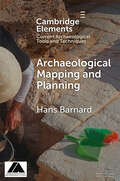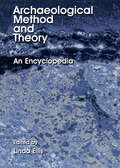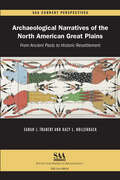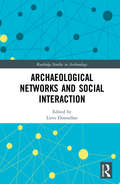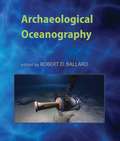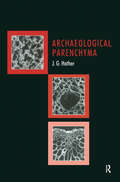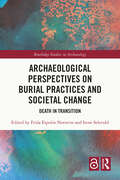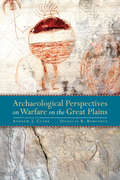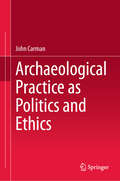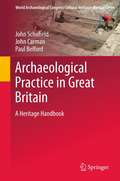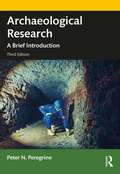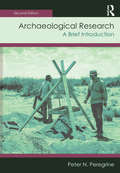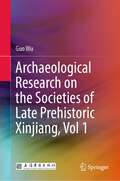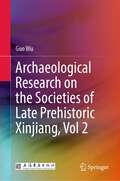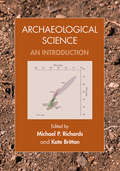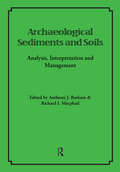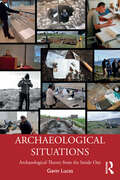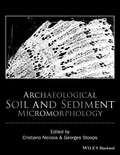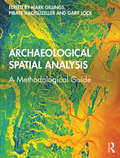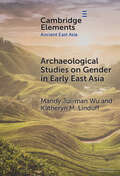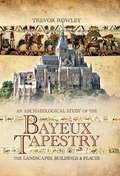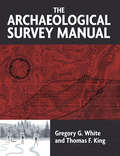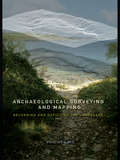- Table View
- List View
Archaeological Mapping and Planning (Elements in Current Archaeological Tools and Techniques)
by Hans BarnardThis richly illustrated Element introduces the reader to the basic principles of archaeological mapping and planning. It presents both the mathematical and the practical backgrounds, as well as many tips and tricks. This will enable archaeologists to create acceptable maps and plans of archaeological remains, even with limited means of in adverse circumstances.
Archaeological Method and Theory: An Encyclopedia
by Linda EllisThis Encyclopedia brings together the most recent scientific information on a collection of subjects that are too often - and inconveniently - treated in separate publications. It provides a survey of archaeological method and theory, as well as the application of physical and biological sciences in archaeological research. Every aspect of archaeological work is represented, from the discovery process to the ultimate disposition of materials. Thus the reader will find entries on subject matter covering: * disciplinary theory * legislation affecting the work of archaeologists * pre-excavation surveying * excavation methodology * on-site conservation techniques * post-excavation analysis The rapid evolution of analytical technology is often superficially treated or not covered at all in textbooks or other commonly available sources. Here, the latest refinements in techniques such as radiometric dating, stable isotopic analysis, and the PCR technique of DNA analysis are presented clearly and authoritatively. The discussion of these techniques is amplified by including results of the work of professionals conducting interdisciplinary research and by covering the methodologi enhancements provided by the physical and natural sciences. Cultural property legislation, regardless of its country of origin, has affected how archaeologists conduct their work. This encyclopedia covers all major U.S. legislation developed for the protection of cultural property, including the recent Native American Graves Protection and Repatriation Act, and offers a substantial article on worldwide legislation concerning the reburial of human remains and its effects on the present and future practice of archaeology. Without some sort of conservation program at the point of excavation, valuable materials may be inadvertently contaminated or destroyed. Many simple and low-cost techniques to promote both sample integrity and long-term preservation for major classes of materials are described in this volume. Traditional treatments of method and theory usually focus on prehistoric periods and are limited in their geographic range. This volume includes discussions based on various historical periods on different continents, as reflected in entries such as Historical Archaeology, Industrial Archaeology, Medieval Archaeology, and Classical Archaeology.
Archaeological Narratives of the North American Great Plains: From Ancient Pasts to Historic Resettlement (SAA Current Perspectives)
by Sarah J. Trabert Kacy L. HollenbackStretching from Canada to Texas and the foothills of the Rockies to the Mississippi River, the North American Great Plains have a complex and ancient history. The region has been home to Native peoples for at least 16,000 years. This volume is a synthesis of what is known about the Great Plains from an archaeological perspective, but it also highlights Indigenous knowledge, viewpoints, and concerns for a more holistic understanding of both ancient and more recent pasts. Written for readers unfamiliar with archaeology in the region, the book in the SAA Press Current Perspectives Series emphasizes connections between past peoples and contemporary Indigenous nations, highlighting not only the history of the area but also new theoretical understandings that move beyond culture history. This overview illustrates the importance of the Plains in studies of exchange, migration, conflict, and sacred landscapes, as well as contact and colonialism in North America. In addition, the volume includes considerations of federal policies and legislation, as well as Indigenous social movements and protests over the last hundred years so that archaeologists can better situate Indigenous heritage, contemporary Indigenous concerns, and lasting legacies of colonialism today.
Archaeological Networks and Social Interaction (Routledge Studies in Archaeology)
by Lieve DonnellanArchaeological Networks and Social Interaction focuses on conceptualisations of human interaction, human-thing entanglement, material affordances and agency. Network concepts in the archaeological discipline are ubiquitous these days. They range from loose concepts, used as metaphors to address a notion of connectivity, to highly formal and mathematically complex predictions of human behaviour. These different networked worlds sometimes clash and rarely converge. Archaeologists interested in network analysis, however, have achieved a much better understanding of the implications of adopting formal methods for studying social interaction and there have been theoretical advancements realising a better synergy between different theoretical perspectives. These nascent concerns are explored further in this volume with regional specialists exploring case studies from Prehistory to the Middle Ages throughout the Ancient and New Worlds, outlining how formal network approaches contribute to studying social interaction archaeologically. This book will be of interest to archaeologists wishing to access the latest research on networks and interconnectivity and how these approaches have been productively modified to archaeological research.
Archaeological Oceanography
by Robert D. BallardArchaeological Oceanography is the definitive book on the newly emerging field of deep-sea archaeology. Marine archaeologists have been finding and excavating underwater shipwrecks since at least the early 1950s, but until recently their explorations have been restricted to depths considered shallow by oceanographic standards. This book describes the latest advances that enable researchers to probe the secrets of the deep ocean, and the vital contributions these advances offer to archaeology and fields like maritime history and anthropology. Renowned oceanographer Robert Ballard--who stunned the world with his discovery of the Titanic deep in the North Atlantic--has gathered together the pioneers of archaeological oceanography, a cross-disciplinary group of archaeologists, oceanographers, ocean engineers, and anthropologists who have undertaken ambitious expeditions into the deep sea. In this book, they discuss the history of archaeological oceanography and the evolution and use of advanced deep-submergence technology to locate and excavate ancient and modern shipwrecks and cultural and other sites deep under water. They offer examples from their own expeditions and explain the challenges future programs face in obtaining access to the resources needed to carry out this important and exciting research. The contributors are Robert D. Ballard, Ali Can, Dwight F. Coleman, Mike J. Durbin, Ryan Eustace, Brendan Foley, Cathy Giangrande, Todd S. Gregory, Rachel L. Horlings, Jonathan Howland, Kevin McBride, James B. Newman, Dennis Piechota, Oscar Pizarro, Christopher Roman, Hanumant Singh, Cheryl Ward, and Sarah Webster.
Archaeological Parenchyma (UCL Institute of Archaeology Publications)
by Jon G HatherThe parenchymous remains of roots and tubers are increasingly becoming recognized as an important category of plant remain alongside seeds, fruits and wood charcoal. Identification is however frequently viewed as problematical and such important indicators of past diet are often left unidentified. This book describes the full range of anatomical and morphological characters used in the identification of the parenchymous remains of roots and tubers. Each of the characters is illustrated by photographs of modern and archaeological plant tissues and by line drawings. Further sections of the book also deal with the examination of archaeological tissues and the preparation of modern plant tissue reference collections.
Archaeological Perspectives on Burial Practices and Societal Change: Death in Transition (Routledge Studies in Archaeology)
by Frida Espolin Norstein Irene SelsvoldArchaeological Perspectives on Burial Practices and Societal Change examines the relationships between burial practices and societal transformations in the past.This book highlights the centrality of burials as archaeological material for the understanding of societal change. It critically reassesses past approaches, and suggests new ways of understanding the relationship between burial practice and change in archaeology. Particular attention is given to archaeological periods where change was especially intense: so-called transition periods. The volume has a wide chronological and geographical scope, spanning the Early Bronze Age to the present day, and ranging geographically from Cyprus to Scandinavia. Recent developments within archaeological methods and theory have sparked discussions about the mechanisms and reasons behind societal changes in the past. This book aims to revive interest in understanding and explaining these changes, which are fundamental questions to the discipline of archaeology. The volume is organised into three thematic parts. The first, Practices, Communities, and Agents of Change, examines the roles individuals and communities play in transforming burial customs, highlighting the non-linear and often chaotic nature of these changes. The second theme, Migration, Identities, and Narratives of Change, challenges traditional narratives of migration and identity formation, proposing more nuanced understandings of how burial practices encapsulate these complex processes. The final theme, Transitions, Tempos, and Complexities, explores the multifaceted nature of societal transitions, emphasising the importance of diverse tempos and scales in understanding these shifts.Archaeological Perspectives on Burial Practices and Societal Change is for students and researchers in archaeology, primarily mortuary archaeology and archaeological theory.
Archaeological Perspectives on Warfare on the Great Plains
by Andrew J. Clark and Douglas B. BamforthThe Great Plains has been central to academic and popular visions of Native American warfare, largely because the region’s well-documented violence was so central to the expansion of Euroamerican settlement. However, social violence has deep roots on the Plains beyond this post-Contact perception, and these roots have not been systematically examined through archaeology before. War was part, and perhaps an important part, of the process of ethnogenesis that helped to define tribal societies in the region, and it affected many other aspects of human lives there. In Archaeological Perspectives on Warfare on the Great Plains, anthropologists who study sites across the Plains critically examine regional themes of warfare from pre-Contact and post-Contact periods and assess how war shaped human societies of the region. Contributors to this volume offer a bird’s-eye view of warfare on the Great Plains, consider artistic evidence of the role of war in the lives of indigenous hunter-gatherers on the Plains prior to and during the period of Euroamerican expansion, provide archaeological discussions of fortification design and its implications, and offer archaeological and other information on the larger implications of war in human history. Bringing together research from across the region, this volume provides unprecedented evidence of the effects of war on tribal societies. Archaeological Perspectives on Warfare on the Great Plains is a valuable primer for regional warfare studies and the archaeology of the Great Plains as a whole. Contributors: Peter Bleed, Richard R. Drass, David H. Dye, John Greer, Mavis Greer, Eric Hollinger, Ashley Kendell, James D. Keyser, Albert M. LeBeau III, Mark D. Mitchell, Stephen M. Perkins, Bryon Schroeder, Douglas Scott, Linea Sundstrom, Susan C. Vehik
Archaeological Practice as Politics and Ethics
by John CarmanThis book is of relevance to all archaeologists and all others concerned with how an interest in the past impacts on the present. This book explores the manner in which archaeology as a discipline and a field of endeavour contributes to the modern world. The focus throughout the book is on practices - the range of different things that archaeologists do and how they do and have done it in order to explore the field as a distinctive aspect of social practice over time. It also concerns the structures – social, political, economic, professional, philosophical – in which archaeology is performed and the consequences for the discipline and its practitioners. Throughout there is a concern especially with archaeology as a field of political and ethical decision-making, aspects well recognised by practitioners but rarely emphasised. The book both asks and answers questions about the perception of archaeology from both within and outside the field. The book draws widely on previous work by the author and others – looking at the techniques of the field, the people involved, the political and social impacts both on and by the field. In doing so it seeks to bring these different perspectives together to create a more holistic idea of what archaeology is, has been, and could be. The book is offered to those outside the field as a justification for archaeology – a field coming under increasing pressure from those who consider it (as so many humanities and social science disciplines) as an expensive luxury.
Archaeological Practice in Great Britain: A Heritage Handbook (World Archaeological Congress Cultural Heritage Manual Series)
by John Schofield Paul Belford John CarmenThis manual provides a unique 'user guide' to practicing archaeology and working in the cultural heritage sector within the diverse settings of Great Britain, comprising of: England, Scotland, Wales, the Isle of Man and the Channel Islands. As part of their training, archaeologists often seek work in parts of Britain, either for experience before travelling elsewhere, or directly as part of their career progression. While this does involve reading published material on excavation techniques, archaeological theory, and specific heritage management practices, or research using the Internet, the ideal preparation to working in Britain for the first time requires practitioners to know a little about a lot. Currently, there is no single resource which provides that primary resource for budding archaeologists. Archaeological Practice in Great Britain will provide just such a resource: presented in an accessible style, with a comprehensive and up-to-date bibliography and lists of useful websites. Professionals with particular areas of expertise will contribute short sections on particular subjects, incorporated into the main text prepared by the authors. Throughout, the specific contexts and differences between the various component nations and regions of Great Britain will be made clear.
Archaeological Research: A Brief Introduction
by Peter PeregrineThe third edition of Archaeological Research introduces the basic methods of archaeological research, including data collection, analysis, and interpretation, as well as considering the state of the field today. With new sections on curating archaeological collections and public archaeology, the third edition also adds a new chapter on the analysis of metals and glass. This popular, concise textbook examines approaches to the archaeological record, sampling and research design, survey and excavation methods and strategies, recordkeeping, dating and analysis of archaeological materials, and the professional practice of archaeology. Archaeological Research continues to be an excellent text for undergraduate students in basic archaeology courses, field methods courses, and field schools.
Archaeological Research: A Brief Introduction
by Peter N. PeregrineThis updated edition of Archaeological Research introduces the basic methods of archaeological research, including data collection, analysis, interpretation, as well as a consideration of the state of archaeology today. New to the Second Edition is updated information on geographic information systems and remote sensing strategies, and a greatly expanded discussion of practices in cultural resource management archaeology. This popular, concise textbook explores various research methods, analytical techniques, legal and ethical issues facing archaeologists; includes discussions of the archaeological process and record, sampling and research design, survey and excavation methods and strategies, recordkeeping, analysis, archaeological dating, presenting results, and research opportunities; is an excellent text for undergraduate students in basic archaeology courses, field methods courses, and field schools
Archaeological Research on the Societies of Late Prehistoric Xinjiang, Vol 1
by Guo WuThis book presents cutting-edge archaeological materials from Xinjiang, from the Bronze Age to the early Iron Age. Through a systematic topological study of major archaeological cemeteries and sites, it establishes chronologies and cultural sequences for three main regions in Xinjiang, namely the circum-Eastern Tianshan region, the circum-Dzungarian Basin region and the circum-Tarim Basin region. It also discusses the origins and local variants of prehistoric archaeological cultures in these regions and the mutual relationships between them and neighboring cultures.By doing so, the book offers a panoramic view of the socio-cultural changes that took place in prehistoric Xinjiang from pastoral-agricultural societies to the mobile nomadic-pastoralist states in the steppe regions and the agricultural states of the oasis, making it a must-read for researchers and general readers who are interested in the archaeology of Xinjiang.
Archaeological Research on the Societies of Late Prehistoric Xinjiang, Vol 2
by Guo WuThis book presents cutting-edge archaeological materials from Xinjiang, from the Bronze Age to the early Iron Age. Through a systematic topological study of major archaeological cemeteries and sites, it establishes chronologies and cultural sequences for three main regions in Xinjiang, namely the circum-Eastern Tianshan region, the circum-Dzungarian Basin region and the circum-Tarim Basin region. It also discusses the origins and local variants of prehistoric archaeological cultures in these regions and the mutual relationships between them and neighboring cultures.By doing so, the book offers a panoramic view of the socio-cultural changes that took place in prehistoric Xinjiang from pastoral-agricultural societies to the mobile nomadic-pastoralist states in the steppe regions and the agricultural states of the oasis, making it a must-read for researchers and general readers who are interested in the archaeology of Xinjiang.
Archaeological Resource Management
by John CarmanArchaeological resource management (ARM) is the practice of recording, evaluating, preserving for future research and presenting to the public the material remains of the past. Almost all countries uphold a set of principles and laws for the preservation and professional management of archaeological remains. This book offers a critical and comparative perspective on the law and professional practices of managing archaeological remains. Beginning with a global history of ARM, John Carman provides an overview of legal and professional regulations governing ARM today. He then turns to consider the main practices involved in managing archaeological remains, namely, their identification and recording, their evaluation for 'significance', their preservation and their presentation to the public. As a whole, the book offers an overview of what ARM 'does' in the world, with implications for understanding the role of archaeology as a contemporary set of practices that determine how future generations will access material remains of the past.
Archaeological Science: An Introduction
by Michael P. Richards Kate BrittonThis book provides an up to date introduction to the exciting, but complex, new scientific methodologies that are increasingly used in archaeological study. Written by an international team of specialists, it provides clear and engaging overviews of a wide array of approaches, including DNA and proteomics, dating methods, materials analysis, stable isotope analysis, and the scientific study of human, plant, and animal remains, among other topics. Each technique is explored through the use of actual archaeological examples, which both explain the methods and highlight their potential applications. The work is carefully illustrated with useful charts, graphs and other images, which complement the detail in the text, and help to articulate the case studies explored as well as the underlying principles of the techniques involved. Feature tables in many of the chapters highlight selected research on each topic, providing useful summaries of the current state and scope of the field for the reader. This volume will serve as a handy reference tool for scholars, as well as a key textbook for courses on archaeological science.
Archaeological Sediments and Soils: Analysis, Interpretation and Management (UCL Institute of Archaeology Publications)
by Richard I. Macphail Anthony J. BarhamA collection of papers focusing on the links between archaeology and the study of geological sediments and soils.
Archaeological Situations: Archaeological Theory from the Inside Out
by Gavin LucasThis book is an introduction to theory in archaeology – but with a difference. Archaeological Situations avoids talking about theory as if it was something you apply but rather as something embedded in archaeological practice from the start. Rather than see theory as something worked from the outside in, this book explores theory from the inside out, which means it focuses on specific archaeological practices rather than specific theories. It starts from the kinds of situations that students find themselves in and learn about in other archaeology courses, avoiding the gap between practice and theory from the very beginning. It shows students the theoretical implications of almost everything they engage in as archaeologists, from fieldwork, recording, writing up and making and assessing an argument to exploring the very nature of archaeology and justifying its relevance. Essentially, it adopts a structure which attempts to pre-empt one of the most common complaints of students taking theory courses: how is this applicable? Aimed primarily at undergraduates, this book is the ideal way to engage students with archaeological theory.
Archaeological Soil and Sediment Micromorphology
by Cristiano Nicosia Georges StoopsArchaeological Soil and Sediment Micromorphology goes beyond a mere review of current literature and features the most up to date contributions from numerous scientists working in the field. The book represents a groundbreaking and comprehensive resource covering the plethora of applications of micromorphology in archaeology. Archaeological Soil and Sediment Micromorphology offers researchers, students and professionals a systematic tool for the interpretation of thin sections of archaeological contexts. This important resource is also designed to help stimulate the use of micromorphology in archaeology outside Europe, where the technique is less frequently employed. Moreover, the authors hope to strengthen the proper application of soil micromorphology in archaeology, by illustrating its possibilities and referring in several cases to more specialized publications (for instance in the field of plant remains, pottery and phytoliths). Written for anyone interested in the topic, this important text offers: Contributions from most of the world's leading authorities on soil micromorphology A series of chapters on the major topics selected among the most recurrent in literature about archaeological soil micromorphology Systematic descriptions of all important micromorphological features Special analytical tools employed on thin sections, such as SEM/EDS, image analysis, fluorescence microscopy, mass spectrometry, among others Numerous cross-references 400 illustrated full-colour plates The resource provides the most current and essential information for archaeologists, geoarchaeologists, soil scientists and sedimentologists. Comprehensive in scope, Archaeological Soil and Sediment Micromorphology offers professionals and students a much-needed tool for the interpretation of thin sections of archaeological contexts.
Archaeological Spatial Analysis: A Methodological Guide
by Mark Gillings Piraye Hacıgüzeller Gary LockEffective spatial analysis is an essential element of archaeological research; this book is a unique guide to choosing the appropriate technique, applying it correctly and understanding its implications both theoretically and practically. Focusing upon the key techniques used in archaeological spatial analysis, this book provides the authoritative, yet accessible, methodological guide to the subject which has thus far been missing from the corpus. Each chapter tackles a specific technique or application area and follows a clear and coherent structure. First is a richly referenced introduction to the particular technique, followed by a detailed description of the methodology, then an archaeological case study to illustrate the application of the technique, and conclusions that point to the implications and potential of the technique within archaeology. The book is designed to function as the main textbook for archaeological spatial analysis courses at undergraduate and post-graduate level, while its user-friendly structure makes it also suitable for self-learning by archaeology students as well as researchers and professionals.
Archaeological Studies on Gender in Early East Asia (Elements in Ancient East Asia)
by Mandy Jui-man Wu Katheryn M. LinduffGendered archaeology in Asia has been studied by archaeologists since the 1990s and scholars have posed questions such as the role and construction of gendered identities in ancient societies. In this Element, the authors review secondary literature, report on to what stage the research has evolved, evaluate methodologies, and use the concept of networking to examine the issues across East Asia, including China, Mongolia, Korea, Japan, and Taiwan. Interestingly, those literatures are not entirely parallel with each other – the authors found, for example, that archaeological investigation was largely bound by national guidelines, by local intellectual traditions, and by changing historiographic interpretations of past events, as well as funding. The complexion of recent studies on gender and archaeology in Asia has often been focused on providing a framework for a grand narrative of each national 'civilization' as the emergence of institutional political structures, including traditional values placed on men and women.
An Archaeological Study of the Bayeux Tapestry: The Landscapes, Buildings and Places
by Trevor RowleyAn analysis of the famed medieval English tapestry through examination of the depicted landscapes, towns, castles, and other structures.An Archaeological Study of the Bayeux Tapestry provides a unique re-examination of this famous piece of work through the historical geography and archaeology of the tapestry. Trevor Rowley is the first author to have analyzed the tapestry through the landscapes, buildings and structures shown, such as towns and castles, while comparing them to the landscapes, buildings, ruins and earthworks which can be seen today. By comparing illustrated extracts from the tapestry to historical and contemporary illustrations, maps and reconstructions Rowley is able to provide the reader with a unique visual setting against which they are able to place the events on the tapestry. This approach allows Rowley to challenge a number of generally accepted assumptions regarding the location of several scenes in the tapestry, most controversially suggesting that William may never have gone to Hastings at all. Finally, Rowley tackles the missing end of the tapestry, suggesting the places and events which would have been depicted on this portion of William&’s journey to Westminster.Praise forAn Archaeological Study of the Bayeux Tapestry &“We all know what the Bayeux Tapestry celebrates in its iconic artwork, but Trevor Rowley goes one step further and looks at the buildings and characters with a view actually identifying them! Absolutely fascinating, brings a whole new dimension to the study of this amazing artefact.&” —Books Monthly &“Rowley&’s arguments are copiously illustrated with details from the tapestry, photographs and plans. It results in very densely packed chapters well worth reading, and you certainly will never look at that tea towel in the same way again.&” —Hexham Local History Society
The Archaeological Survey Manual
by Thomas F King Gregory G WhiteGovernmental guidelines have forced a dramatic change in the practice of archaeological surveying in recent decades. In response to public and private development, surveying is needed to accurately inventory the cultural resources of a region and provide guidance for their preservation and management. Greg White and Tom King provide a handy introduction to students, field novices, and land managers on the strategies, methods, and logic of contemporary survey work. In addition to providing the legal and historical context for this endeavor the book provides a heavily illustrated, practical guide to conducting a survey to help beginners understand how it works in practice. This volume is perfect for an archaeological methods class, field school, or reference collection.
The Archaeological Survey Manual
by Gregory G White Thomas F KingGovernmental guidelines have forced a dramatic change in the practice of archaeological surveying in recent decades. In response to public and private development, surveying is needed to accurately inventory the cultural resources of a region and provide guidance for their preservation and management. Greg White and Tom King provide a handy introduction to students, field novices, and land managers on the strategies, methods, and logic of contemporary survey work. In addition to providing the legal and historical context for this endeavor the book provides a heavily illustrated, practical guide to conducting a survey to help beginners understand how it works in practice. This volume is perfect for an archaeological methods class, field school, or reference collection.
Archaeological Surveying and Mapping: Recording and Depicting the Landscape
by Philip HowardA comprehensive and practical guide to surveying for archaeologists, with clear instructions in archaeological mapping, recording field work and detailed case studies from the UK, Europe and the US. Philip Howard provides a user’s guide to methods and instruments of surveying to enable archaeologists to represent their own fieldwork confidently and independently. Archaeological Surveying is an invaluable resource which: provides beginner’s instructions to software used in computerised surveying, including IntelliCAD 2000, Terrain Tools, Christine GIS and Global Mapper introduces the archaeologist to a range of surveying instruments such as GPS, electronic distance measures, theodolites and magnetic compasses includes low-cost software. This textbook is an essential read for any field archaeologists who are in need of an introduction to surveying, or simply wish to update their techniques.
